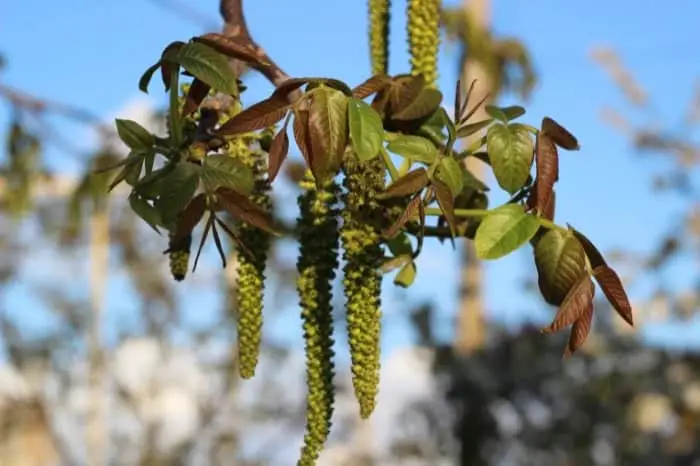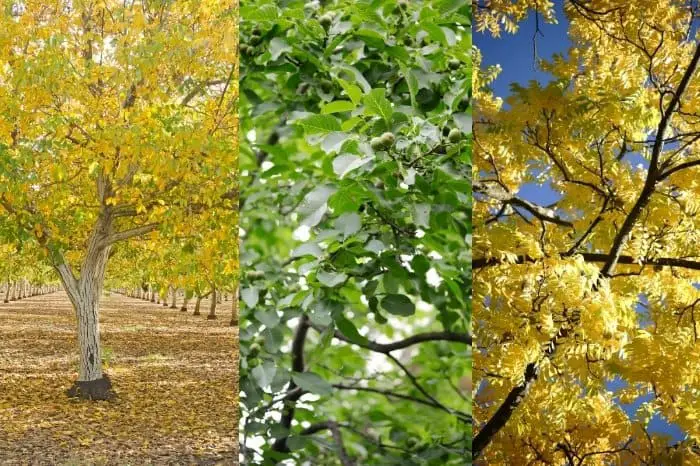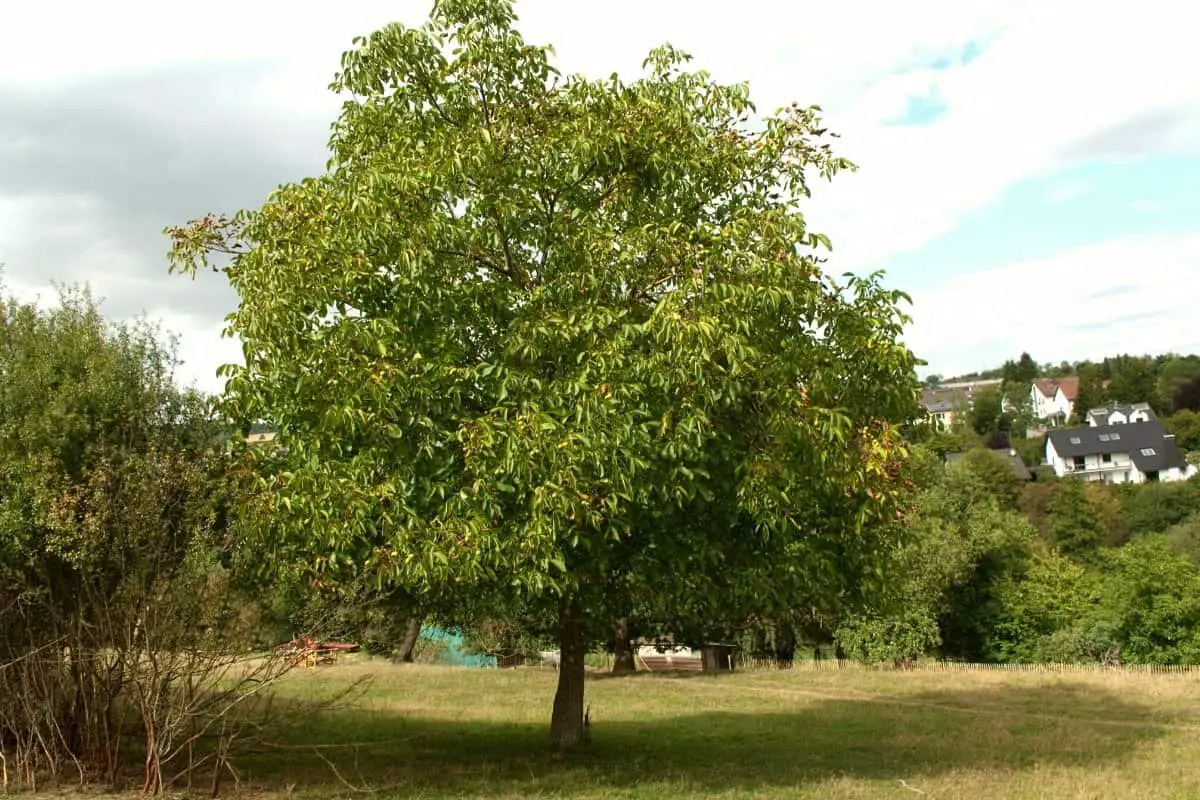Last Updated on February 3, 2022 by
Black walnut trees grow across the Central-Eastern part of the U.S, and most gardeners want to know what does a black walnut tree look like?
These trees are part of the plant family Juglandaceae that includes all the walnuts and hickory trees.
There are 21 species in this genus family growing across southeast Europe to Japan and southeast Canada.
Black walnut species in North America include:
- Black walnut
- Butternut
- Arizona walnut
- Two species in California
The two most common walnuts in the native locations are the butternut and black walnut.
These trees prefer growing in riparian zones – creeks, rivers, and denser woods. They grow in sunny areas and are classified as shade intolerant.
Black Walnut Tree Identification
Walnut identification is easily made by getting to know its features – the bark, leaves, and buts are different. The walnut bark is light gray to dark brown; the leaves are pinnate, with some species carrying larger leaves than others. The nuts look similar, but the taste and texture can differ.
Let’s look at each of the walnut features that will help us identify these trees even better.
The Black Walnut Tree Bark
It has deep ridges that run vertically up and down the trunk. The bark color can be brown or dark gray with diamond-shaped patterns. Some varieties of walnut have smoother, lighter bark.
The Black Walnut Tree Twigs
The twigs are light brown and stout, with leaf scars forming 3 lobes of a shield shape. They resemble a monkey face. The scar does not contain any hair on the upper portion of the scar, but the butternut type contains. The twigs pith is light brown and is separated into different chambers.
The Black Walnut Tree Leaves
The leaves are pinnate with pair of leaflets. They also have a single leaf at the end of the twig with the largest leaflet at the center. The leaves carry about 5 to 25 leaflets in each twig. In the fall, all walnut leaves turn yellow or brown.
The Black Walnut Tree Flowers
The black walnut tree is monoecious – this means the male and female flowers are separate. Male flowers look like long catkins, hanging from the leaf scars of the previous flowers. Each floret is about 1/8 inch wide, with 15 to 40 stamens and a small calyx of 5 to 6 scales.
Female flowers are grouped into 2 to 5 pieces on short spikes near the end of the twig of new growth. They are about 1/8 inch long, with a 4-lobe calyx of fine hair, pistil, and a 2-lobed style. The flowers come as the leaves are beginning to develop. Pollination happens by wind or self-pollination of the female flowers.

The Black Walnut Tree Fruits
These flowers mature into hard but enclosed nuts. They are enclosed in a furrowed hard husk that is contained in a round husk. The husk is 2 to 2-1/2 inches in diameter.
At first, the outer husk is green, then turns very dark at maturity. The fruits are either single or double together. Even after growing, the outer shell does not open by itself.
When growing, they look like small round or oval green balls. The nut is carried in a hard-brown shell and tastes from earthy, mild to sweet, and sometimes bitter.
What Does A Dormant Black Walnut Tree Look Like?
When the walnut tree is dormant, you can still identify it by looking at the bark, leaf scars, and nuts on the ground all around the tree.
Black walnut has furrowed and dark-colored bark. The leaf scars along the twigs look like an upside-down shamrock with 5 to 7 bundle scars. You will find lots of walnuts or their husks under the tree. Their nuts are roughly globular or round.
Bonide (BND212) – All Seasons Horticultural and Dormant Spray Oil, Insecticide Concentrate
Facts About A Walnut Tree
- Walnut has 21 species in the walnut family (Juglandaceae).
- Black walnut and English walnut trees are the most common walnut tree varieties.
- Other walnut varieties include butternut, Andean Walnut, California black walnut, Japanese walnut, and little walnut.
- All these walnut varieties are native to Asia, Europe, North America, and China.
- The nut is the seed that’s produced as the fruit.
- Walnut tree timber is a prized type of hardwood and makes the best furniture.
- Its wood is dark brown, almost chocolatey in color.
- Their texture is beautiful grain, and its color makes it ideal for making cabinets or carving bowls.
- Walnut trees thrive in hardy USDA zones 4-10
- The black Walnut trees grow to at least 12-30 inches per year, depending on the conditions provided.
- This tree starts producing nuts at 5 years old and continues until it reaches 10 years.
- Walnut nuts attract wildlife like chipmunks, squirrels, etc.
- The entire tree produces juglone that prevents or kills certain plants growing under or near them.
- Shavings from the black Walnut must not be used horse bedding cos it’s toxic to them.
Walnut Tree Varieties
Walnut comes in many varieties, but the three most common include:
- The Black walnut (Juglans nigra). This walnut tree has dark-colored bark with deep furrows on the tree trunk, giving it a rough feel. Its foliage includes pinnate leaves, and the nuts grow in a rounded green husk.
- The English walnut (Juglans regia). The English walnut has an olive-brown, smooth bark when young, but it develops wide fissures as it grows. Just like the other walnut species, its leaves are pinnate but smaller. The entire fruit of the English walnut is edible and has a rich flavor.
- The Butternut (Juglans cinerea) is also called the white walnut tree. The Butternut has a light gray bark but with a smoother feel than the black walnuts. Its leaves are pinnate with about 17 leaflets. Its nuts are oval.

Conclusion
Black walnuts are the most valuable and versatile trees in North America. They are valued by the first nations for their drupes and dye abilities. They are loved by the wildlife because they provide food and shelter, and the modern culture values it for its furniture, food, and industrial applications.
The black walnut is excellent for the future as a great addition to the permaculture system. It provides a habitat for the next generation.
Now that you know how a black walnut tree look like, why don’t you go ahead and enjoy growing your own!
FAQs
Why is the black walnut tree so important?
The black walnut (Juglans nigra) is one of the most iconic trees in North America, and for good reason. It’s hardy, prolific, and easy to grow. The tree can be found in nearly every state in the US and Canada. In addition to its many uses as food, it’s also an important source of lumber.
How do you tell if a tree is a black walnut?
You can look at the leaves. Black walnuts have serrated leaves, while common walnuts are smooth-edged. The leaves of both are green in summer and autumn. Black walnuts are deciduous and shed their leaves in winter, but common walnuts are evergreen. The tree is about 40 feet tall, with a trunk diameter of 1 to 2 inches.
Look for the following characteristics:
A dense canopy that can shade out other trees.
A tall, slender, open structure that makes a good windbreak.
A broad crown with a spreading base that has a few main branches and then a lot of smaller secondary branches.
A broad base that tapers down to a point at the top.
Branches that grow from the bottom up.
Leaves that are oval in cross section and have a prominent midrib.
Foliage that is green and shiny when it's new but turns a darker, more lustrous green as the leaves mature.
Fruit that hangs in a pendulous cluster.
Dark, rich red-purple colored nuts that are usually encased in a hard shell.
What do black walnuts look like?
Black walnuts are not really nuts. They are the fruit of a deciduous tree that bears in fall and winter. The fruit is a round, 1-1/2-in.-diameter drupe, the color of which is variable. The color ranges from nearly black to yellow-green and orange. The fruits contain a soft edible kernel (the nut) surrounded by a hard, leathery shell.
How big do they get?
Black walnut trees are very large trees, and they are often used as a reference for the size of other trees. They are also the most commonly found tree in the United States and Canada. They can grow to be 50 feet tall or more, but the majority of them have a height around 25 to 30 feet.
It can grow as tall as 100 ft and has a diameter of about 8 feet.
Where can they be found?
Black walnuts can be found almost anywhere in North America. You may be surprised at how many of them there are. In fact, in the United States alone, it’s estimated that more than one billion black walnuts grow.
Caroline is a gardener who loves to get down to the nitty–gritty of gardening. She proudly proclaims herself as a ‘dirt worshipper‘ and can often be found deep in the garden, covered in soil and singing to her plants. As a self–proclaimed ‘plant whisperer‘, Caroline believes that plants need love and attention just like any other living thing, and she loves to give them both. When she‘s not tending to her garden, you can often find her researching the latest gardening trends, or teaching others how to make their gardens thrive



